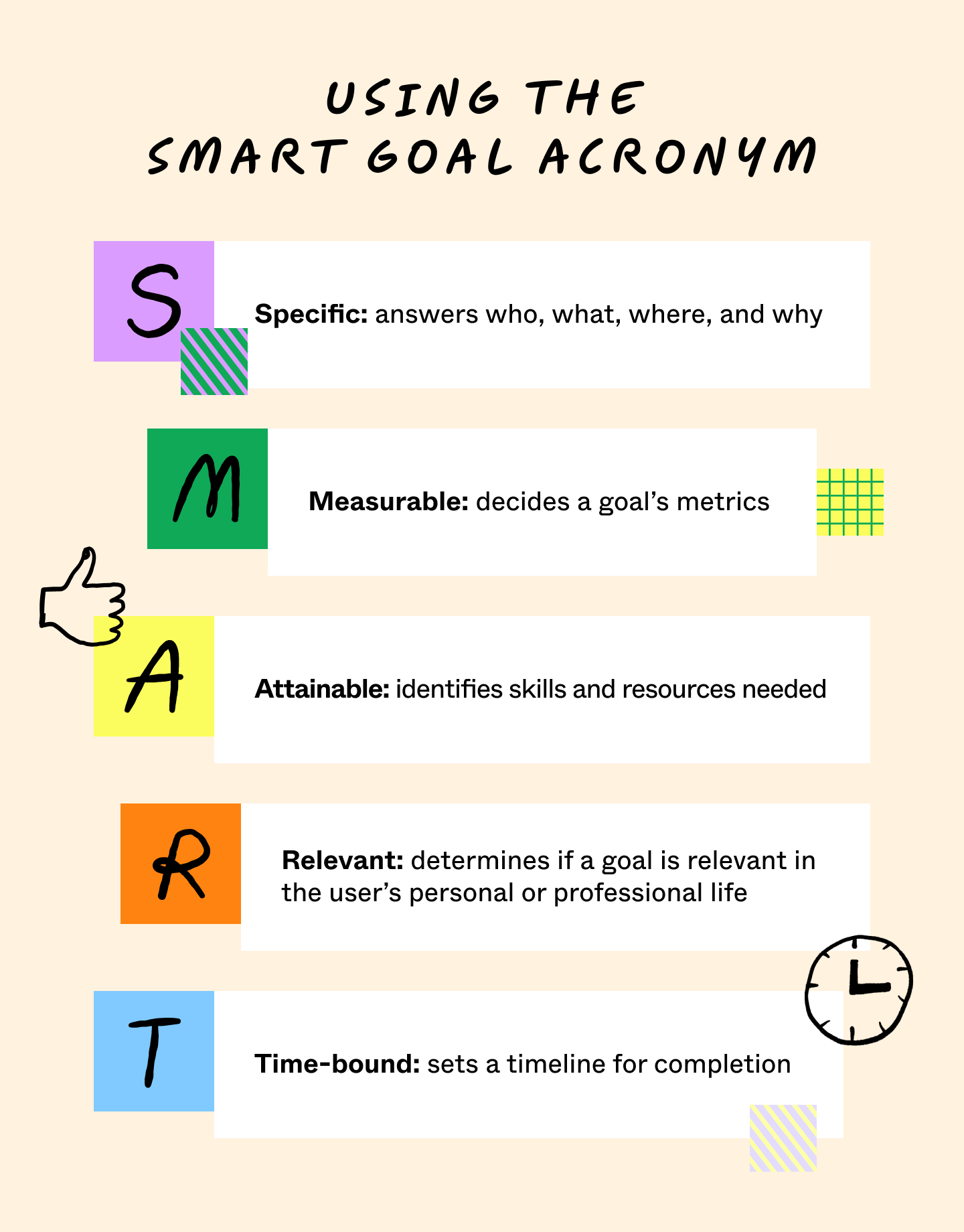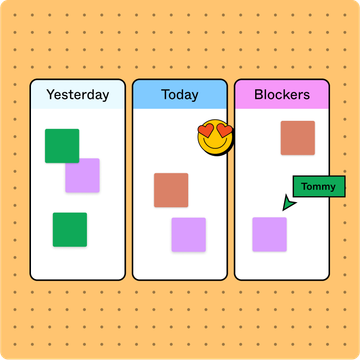How to write SMART goals (with examples)

Whether you're figuring out how to ship a new feature or make a career pivot, you probably have short- and long-term goals—on both a professional and personal level—that you want to achieve. But where do you start?"
The first step is defining the right kinds of goals. Enter: the SMART goals framework, which can help you set goals that are specific, measurable, attainable, realistic, and time-bound. Below, we’ll explain what SMART goals are, cover a few examples, and share tips for writing them.
What are SMART goals?
SMART goals were introduced in 1981 by George T. Doran, who originally said, “There’s a SMART way to write management goals and objectives.”
This approach to goal setting is popular for both professional and personal objectives. Here’s a breakdown of each part of the acronym:
- Specific: Target a specific area for improvement
- Measurable: Define the metrics you use to gauge goal progress
- Attainable: Objectives match your skill level and resources
- Relevant: Goals directly apply to your work, life, and available tools
- Time-bound: Specify when the results of your goal setting will appear
In-post image: the current image of SMART template
Why do SMART goals matter?
The SMART goal framework can help you brainstorm objectives and track progress toward your goals. By getting into the nitty-gritty details, you avoid pitfalls like ambiguity and procrastination.
Locke’s Goal Setting Theory, first introduced in the 1960s, found a positive relationship between clearly identified goals and performance. The SMART goal framework allows your conscious ideas to influence actions and decisions, increasing the chance of reaching your goal.
How to write SMART goals
Let’s say one of your goals is to increase your organization’s revenue. A broad goal like this will become easier to achieve if you define the details.

Specific
First, you need to keep your goal specific. For our example, you need to decide how to bring in more revenue. You can refine these details by asking“W” questions before moving forward:
- Who: Who should become involved in the goal for it to succeed? Consider the teams, stakeholders, and partners who will help you reach your goal.
- What: What do you want the end result to be? Use as much detail as possible to show the importance of this objective.
- Where: Where will you reach your goal? This question only applies to goals completed at a certain event or in a specific area.
- Why: Why does this goal matter? Think of this question as a defense or justification of your objective.
Example: You should aim to boost your year-over-year revenue by 5%.
Measurable
After specifying a goal, decide how to measure your success and pick metrics to track. You can also break larger goals into smaller objectives and milestones. These checkpoints help you quickly identify when you’ve fallen behind, stayed on track, or outpaced your timetable.
Example: You should regularly meet with sales and product managers about your problems and opportunities. Within three months, check your product improvements or new sales leads to see if you’re on track to boost earnings.
Attainable
To see if a goal is attainable, ask what you need to know or use to reach the goal. You may have to learn a new skill set or do some additional research to make a goal attainable. If your timeframe is too short or the skills needed are too complex, rethink your initial objective.
Example: Based on industry research, similar businesses improved their revenue by 5% year-over-year. So, you should research their methods and see if you have the tools to replicate their success.
Relevant
For professional SMART goals, your objectives should align with company-wide goals. Ideally, reaching your SMART goals will benefit your company and the teams within it. Showing how these goals are relevant to everyone will motivate your teams.
Example: Improving your company’s bottom line helps everyone involved in it. Higher revenue boosts dividends, gives your employees more job security, and offers leaders the funding to invest in new strategies.
Time-bound
No matter how big or small a goal is, it should follow a timeline. With fair and frequent deadlines, it’s easier to stay motivated when you’re working toward a goal. You can create a sense of productive urgency by setting realistic deadlines.
Start setting smarter goals today w/ FigJam
Use FigJam's free template to set your goals within minutes.
SMART goal examples
SMART goals organize your business, team, and personal objectives. Here are a few examples that explain the SMART goal-setting process.
Professional SMART goal
The SMART goals framework can help you turn a vague goal into a more specific and actionable objective.
General goal: “I want to improve my professional performance.”
- S: Currently, I am underperforming compared to my peers. I have not made as many sales as others in my position, and my contacts are lower caliber. I would like to improve my performance so it’s comparable to my team.
- M: I will measure my performance by the number of sales I can complete before my next evaluation.
- A: To improve my professional skills, I will invest in industry-specific training and reach out to my supervisors about potential skill labs and shadowing opportunities.
- R: 60% of my job is completing sales. As the success of our company relies on consistent sales and renewals, this goal is incredibly relevant to our company’s bottom line.
- T: I would like to see improvement by my next review period.
SMART goal: To grow my professional skills and make a positive impact in my company, I will need to improve my sales. Investing in online or in-person training will help me increase my sales by 5% by my next review period.
- Milestone: Complete a sales training course within three months
- Deadline: The upcoming review period in six months
Team SMART goal
Team SMART goals help your team collaborate on a shared objective. They can draw from company-wide objectives or needs specific to the team members you work with.
General goal: “We want to increase team collaboration.”
- S: Our team members work apart instead of forming a unified group. To increase productivity and cooperation, we’ll create a welcoming environment that improves collaboration across all projects.
- M: About 50% of our projects should include some form of collaboration. We would like to see a 25% increase in collaboration to make this goal a success.
- A: Our department encourages teamwork with collaborative workspaces available.
- R: Department and company goals focus on increased collaboration and co-branding opportunities.
- T: Our team should see improvement in six months.
SMART goal: Increasing collaboration is vital to improving current workflows and projects. Within six months, at least 25% of all department projects should include collaborative work. This cooperation can involve research, writing, editing, design, or distribution.
- Milestone: Complete two team-building activities before the next quarter begins.
- Deadline: Within six months
Personal SMART goal
You can set personal SMART goals for almost anything. Here, let’s turn a broad exercise goal into a specific and measurable fitness objective.
General goal: “I want to run faster.”
- S: I run approximately once a week and have seen little to no improvement in my times. By the end of this goal, I would like to decrease my mile time by ten seconds.
- M: While I can compare mile times week by week, I should track additional metrics for this goal. Mileage should increase by 5% each week, and my stride turnover should increase each month.
- A: My goal to reduce my mile time over the course of a year will allow my body to adjust to this increased physical activity level and build up my stamina safely.
- R: Physical fitness is important to me, and running consistently can improve my health.
- T: I should see changes within one year.
SMART goal: Increasing endurance and physical fitness are crucial to improving my running speed. By increasing my weekly mileage by 50%, boosting stride turnover to approximately 180 strides per minute, running up stairs consistently for one minute, and training approximately four to five times per week, I should decrease my mile time within a year.
- Milestone: Increase weekly mileage by 25% within six months of training.
- Deadline: One year
Benefits of SMART goals
SMART goals offer a format to set realistic objectives and metrics gauging success. Additionally, SMART goals improve:
- Communication: SMART goals provide ample space for goal-related questions and conversations. In professional settings, this keeps a conversation going between you and collaborators.
- Alignment: Professional, team, and personal goals highlight you or your organization’s larger objectives.
- Clarity: Specific goals eliminate ambiguity and help you prioritize tasks. Well-written SMART goals give you a step-by-step path to completing tasks.
SMART goal-setting tips
Consider these best practices and tips when writing your SMART goals.

Use the “Goldilocks” rule
Today, the “Goldilocks Principle,” based on the classic story, describes a balance that is just right—not too easy or too hard—which is key for goal setting. If your goal is too easy, it’s difficult to take it seriously and stay motivated. So, keep your goals realistic but challenging enough to stay motivating.
Set up systems
Goals won't get you where you want to go if you don’t have the systems to support them. Every time you check off part of your plan, update your systems. Eventually, this data helps automate rote work and streamline processes. Bottom line: good systems turn the goal-setting grind into a more enjoyable, productive process.
Share goals with team members
SMART goals for teams and professionals should align with your project and strategic objectives. Sharing goals across your entire team holds everyone accountable for their milestones and deadlines. Plus, team members can prioritize tasks for others, creating a collaborative goal-setting environment.
Monitor progress regularly
Consider creating regular progress check-ins and using SMART timelines and metrics to track your progress. Don’t be afraid to adjust your timeline or goal specifics, even if you’ve exceeded or missed expectations.
Be honest about your progress by asking yourself:
- Is my timing realistic?
- Which methods were helpful?
- Which deliverables were out of my control?
- What can I adjust?
Set smarter goals today with FigJam
Now that you know how to write SMART goals, you can turn that “goal” into a “go!” Using FigJam, you can visualize your SMART goals for professional, team, and personal environments while collaborating asynchronously with others.
Consider using a goal-tracking template to understand your goal progress and adjust your objectives throughout your timeline. SMART goals can be as dynamic as you, so don’t be afraid to fine-tune them throughout the process.
Keep reading

How to create a flow chart
Having a flow chart can help visually represent actions or people in a complex situation.
Learn more

How to create a project status report
Whether you’re developing a new product or launching a marketing campaign, your company’s success hinges on keeping your project on track
Learn more

How to run great daily standups
How do you make sure everyone's on board, on task, and on track for a productive day ahead?
Learn more





